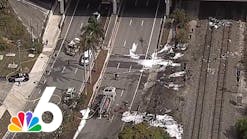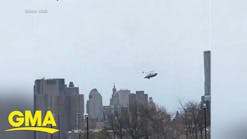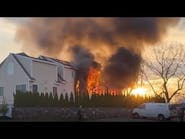July brings many joyful events. Fireworks on the Fourth of July, family picnics and vacations, the celebration of our national pastime with the Major League Baseball All-Star Game and the kick-off of NFL training camps are events that everyone can be excited about. But, July also brings wildfire season. June 30-July 6 is Wildland Firefighter remembrance week and July 2 is National Wildland Firefighter Day. Both of these events remind us that July has seen some of the most tragic wildfires in U.S. fire service history. Here is a recap of some of them.
July 1, 1998, Hackensack, NJ Auto Dealer fire
On Friday, July 1, 1988, the Hackensack, NJ, Fire Department started receiving calls reporting flames and smoke coming from the roof of a Hackensack Ford Dealership.
According to the NFPA Summary of the event, “two engines, a ladder company, and a battalion chief responded to the first alarm assignment. The first arriving fire fighters observed a 'heavy smoke condition' at the roof area of the building. Engine company crews investigated the source of the smoke inside the building while the truck company crew assessed conditions on the roof. For the next 20 minutes, the focus of the suppression effort was concentrated on these initial tactics.”
With little headway being made, the battalion chief ordered everyone out as the shift was going to be made to take a defensive fire attack.
The NFPA Summary continues: “However, before suppression crews could exit from the interior, a sudden partial collapse of the truss roof occurred, trapping six fire fighters. An intense fire immediately engulfed the area of the collapse. One trapped fire fighter was able to escape through an opening in the debris. The other five died as a result of the collapse.”
In his July 2011 Firehouse article, “Remembering Hackensack and Gloucester,” Christopher J. Naum reports that “Capt. Richard L. Williams and Firefighters William Kresja and Leonard Radumski were killed instantly, and four other firefighters escaped. Lt. Richard Reinhagen and Firefighter Stephen Ennis survived the initial collapse and found refuge in a tool room where they spent the next 13 minutes calling for help. Despite heroic rescue attempts, they succumbed to carbon monoxide poisoning. Approximately 90 minutes after the collapse, firefighters located the bodies of their fallen comrades.”
Ten years after the fire, then-Firehouse Editor-in-Chief Harvey Eisner wrote, “On July 1, 1988, five Hackensack, NJ, firefighters were killed in the collapse of a wooden bow string truss roof at a fire involving an auto dealership. Firehouse® presented three stories on the disaster in the following 16 months. Now, Firehouse® reviews the fire, investigations, conclusions and recommendations made. We also examine the progress and accomplishments of not only Hackensack , but those made by other departments since the tragedy. This fire was a traumatic experience for firefighters and their families. The scars may never heal, but if we can learn from the past it is our intent to prevent such occurrences.”
Read the article here.
July 4, 2002, Gloucester City, NJ—Residential roof collapse
On July 4, 2002, the Gloucester City Fire Department was dispatched for a reported house fire. Responding units were advised that occupants may be trapped. First-arriving units were on scene in less than three minutes.
In his July 2011 Firehouse Magazine article, “Remembering Hackensack and Gloucester,” Christopher J. Naum reports that first responders found heavy fire on all exposures of a three-story multi-family dwelling and initiated a search for entrapped occupants. One occupant was rescued, but due to the severity of their injuries, they were unable to give information regarding the whereabouts of any other occupants.
While the aggressive interior attack and rescue mission continued, a partial collapse of the structure occurred. An emergency evacuation signal was sounded and while that was commencing a further and much more substantial collapse occurred trapping eight firefighters inside.
Five of the eight trapped firefighters were rescued, but three firefighters and three children were killed. The firefighters were identified as Mount Ephraim Chief James Sylvester, Mount Ephraim Deputy Chief John West and Gloucester City Firefighter Thomas G. Stewart III.
Firehouse.com reported when the National Institute of Occupational Safety and Health released its findings on the incident.
Twenty-two years after his father was killed in the line-of-duty, Firefighter Nicholas Stewart reported for his first shift at a Gloucester fire station.
July 5, 1973, Kingman, AZ—Doxol Gas Company
On July 5, 1973, a propane tank car being off-loaded in Kingman, AZ, caught fire, resulting in a BLEVE (boiling liquid expanding vapor explosion) that killed 11 Kingman firefighters and one civilian.
During a propane transfer from a railroad car to a storage tank at the Doxol Gas Distribution Plant, a leak was detected in one of the fittings. An attempt to fix it by striking the fitting with a wrench caused a spark that ignited the leaking propane gas. The initial fire quickly escalated, with flames shooting 70-80 feet into the air. Kingman firefighters arrived on scene within three minutes of the first call. The fire spread quickly and was impinging on the top of the rail car where the vapor space is located when firefighters arrived.
Firehouse Hazmat Editor Robert Burke, who wrote about the incident when he covered the 35th anniversary memorial service, said, “This is the most vulnerable place for flame impingement to occur because there is nothing to absorb the heat but the metal itself. Steel does not absorb heat well, so when temperatures top 400 degrees Fahrenheit, the integrity of the tank is quickly in jeopardy.”
As firefighters tried to cool the tank, the BLEVE occurred. Burke reported that “Eleven Kingman firefighters—two career and nine volunteer—died as a result of burns from the explosion. Three were killed instantly and eight more passed away over the following week. The fireball and radiant heat set five buildings on fire, including a tire company, restaurant, truck stop and the gas company office building, and started several brushfires.”
The 11 Kingman firefighters who were killed that day were:
- John O. Campbell
- William L. Casson
- Joseph M. Chambers
- M.B. (Jimmy) Cox
- Alan H. Hansen
- Frank (Butch) Henry
- Roger A. Hubka
- Christopher G. Sanders
- Arthur A. Stringer
- Donald G. Webb
- Richard Lee Williams
On the 25th anniversary of the tragedy, Burke spoke with Capt. Wayne Davis, the only firefighter in the area who was at the explosion and is still active in the fire department.
July 6, 1994, Glenwood Springs, CO—South Canyon Mountain
On July 2, 1994, near the base of Storm King Mountain, a lightning strike started yet another wildfire. Area fire resources were already taxed by a number of fires due to drought conditions with record temperatures and low humidity throughout the region.
In “The South Canyon Fire: 25 Years Later,” Tom Harbour reported that “On the afternoon of July 6, a dry cold front moved into the area with winds up to 45 mph fanning the flames through dense Gambel oak—a highly flammable brush. Flames, later reported as high as 300 feet and racing along at 18 mph, burned up the rugged hillside forcing firefighters to retreat. Twelve firefighters and two helitack crew members were killed trying to outrun the fire.
Three dozen firefighters were able to escape from the deadly flames using fire shelters or seeking out safe areas as the wall of flames consumed everything in its path.
Killed in the fire were:
- Kathi Beck
- Tami Bickett
- Scott Blecha
- Levi Brinkley
- Robert Browning
- Doug Dunbar
- Terri Hagen
- Bonnie Holtby
- Rob Johnson
- Jon Kelso
- Don Mackey
- Roger Roth
- James Thrash
- Richard Tyler
In his article, “The South Canyon Fire: A Remembrance Five Years Later,” Robert M. Winston paid tribute to “The Fourteen” and focused on the lessons learned to help prevent another tragedy.
Other Major Incidents This Month in Fire History
July 6, 1944, Hartford, CT—Ringling Bros. and Barnum & Bailey Circus tent fire kills 168
July 9, 1953, Mendocino National Forest, CA—Forest fire kills 15 firefighters
July 23, 1984, Romeoville, IL—Union Oil refinery fire kills 17; losses worth $177 million
July 24, 1931, Pittsburgh—Little Sisters of the Poor home for the aged fire kills 48
July 28, 1945, New York City—Fire after B-25 crash into Empire State Building kills 14
July 29, 1956, Sun Ray, TX—Shamrock Oil & Gas Corp. refinery fire kills 19 firefighters







